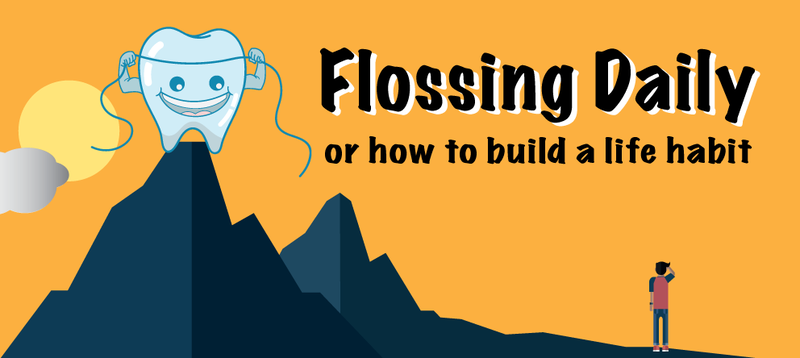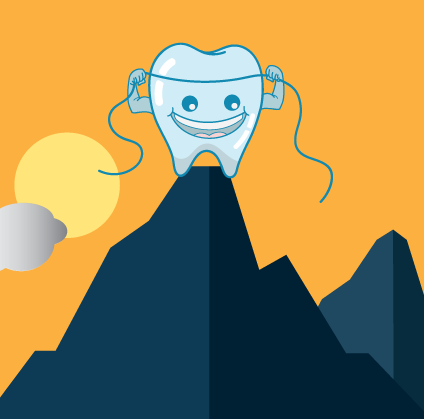
Floss. A plastic box of string, unused yet lingering in the bathroom since you last visit to the dentist. Its mint-tinted flavor is an artifact of our human health progress. Floss, its presence a guilty reminder that you should floss. Your dentist says. The internet says. Your mom says.
But you don’t. You don’t floss.
Most people don’t floss regularly. According to an oral health survey by the American Dental Association, “Only four of 10 Americans floss at least once a day, and 20 percent never floss.”
We also lie about our flossing habits. In a report from NPR, nearly one out of four “lie to their dentists about how often they floss their teeth.”
So you don’t floss and maybe you even lie about it from time to time. I’ve been there.
While I’m a goal-driven and productive dude, I too have struggled on multiple attempts to floss regularly. About three months ago, “floss daily” came up in my list of positive habits I should work on. I once again decided to build this habit into my routine. Fortunately three months later I can claim to have successfully incorporated flossing into my daily routine. According to my records, I’ve flossed daily for 90+ days.
There were three basic techniques I used to start and continue flossing regularly: 1. habit chunking, i.e. the process of combining new activities onto existing habits, 2. activity tracking wherein I track if I did the thing I’ve set out to do, and finally, 3. enjoy and experience the moment. Along with a couple of interesting tweaks, I become a daily flosser.
Here is how I did and what I’ve learned about flossing and daily habits. Here’s how you can learn to floss daily (or build any habit for that matter).
Habit Chunking and Flossing

New habits are best built on top of existing one. They call this technique “Habit chunking,” and it is one of the more powerful ways to add a new habit or process into your life. You incorporate new habits to existing ones. Basically when you are about to do something or just did something you normally do, you add this new thing. For example, like when drink a glass of water, try to have a mindful moment.
I brush my teeth each and every day, morning and night. So my first step, since I was already brushing regularly, was to use my morning and evening habit of brushing and add flossing. My trigger to brush became a trigger to floss first.
During the initial 30 day on-boarding, I did a couple of experiments, like flossing before I brushed. I picked up this idea from LifeHacker and it was really helpful to me. By flossing before you brush, you get to keep the clean sensation you get post-brushing.
I also experimented with flossing speed trials wherein I attempted to floss in increasingly fast intervals. It never hurts to turn something into a challenge.
Like setting out your running shoes before bed or putting your phone across the room when you go to sleep, physical objects and their placement can also help you in building a new habit. For flossing this meant strategically placing a box of floss where it would trigger me to take action or, at least guiltily, remind me to take action. For me I keep my box of floss next to my glasses, so immediately when I wake up and put on my glasses I also notice my box of floss and I am reminded.
So, when it comes to building a new habit like flossing, it helps to “combine” that new task with an existing routine. This old habit provides a trigger and once they are “chunked” together you can be pretty sure you’ll do them.
Track It and Become Accountable
My second step was to track this goal. Tracking is key. If you don’t measure a goal, then it’s impossible to know if you are hitting it. Since I track my goals, habits and morning routine, it was easy to add flossing to my list. As part of my tool kit of productivity tools, I use Habitca dailies to check-in daily habits and routines.
I committed to an initial streak. It’s often claimed that you should aim at a 21-day streak in order to create a habit. This may or may not be true, but the spirit of the idea is important. You want to get beyond the initial honeymoon period where this activity is a new thing; you want it to be an established, you-do-it-automatically thing. This takes time so aim to just keep going.
Mentally I look at these streaks as building links in a chain. Each time you check-in floss or running or whatever daily habit you have, you add a link in the chain. The longer that chain is the more obliged you feel to keeping it up.
While tracking tends to more on the extreme end of the quantified self movement, more and more things exist that allow you passive track you movements and activities. Passive tracking is great, but sometimes actively checking in things you’ve done can be highly reinforcing too.
So, tracking in this way has two benefits. First, it makes the goal measurable and you accountable. Second, the check-in’s become like a mental performance where you visualize and verbalize the actualized and improved self you’ve become. You become mentally stronger.
Enjoy and Experience the Moment
If the first step is to combine your new flossing habit with an existing routine like brush and the second step is track it, then the final aspect of turning flossing into a life activity is to learn to enjoy it or at least experience it.
Unfortunately not a lot of people like flossing, myself included. In fact, as NPR reported, “more than a third of people surveyed would rather be doing unpleasant chores than flossing their teeth daily. Fourteen percent would rather clean the toilet. Nine percent would rather sit in gridlock traffic for an hour. And 7 percent would rather listen to small children crying on a plane.”
It’s difficult to say why so many people dislike flossing. There are of possible explanation. For me personally, I floss so rarely that a typical flossing experience ends with bleeding gums.
Each year has been a testament to my failure to floss. My gums throbbing and bloody after a yearly clean at the dentist. Each session ends with a reminder by the dentist or hygienist that I should floss and, of course, a small “gift” bag with a new toothbrush, toothpaste and a box of floss. That’s typically my only box of floss I have per year. I have an accumulation of them, lingering around my travel bags and assorted bathrooms.
So, while I know the heath benefits of flossing, I’ve fail to floss. Part of the problem is that my gums hadn’t adapted to regular flossing. With this in mind, I mentally committed to flossing daily for a period and hopefully my gums would improve. Fortunately they did.
Beyond getting over this pained, bleeding gums, there is something to be said about learning to enjoy and staying in the moment of doing something. This is part of a long tradition of meditation, especially breath-focused meditation, wherein you train yourself to stay focused on what you are doing in the here and then now.
Flossing, while strangely not mentioned in any of the books and articles I’ve read on meditation and mindfulness, is an incredible opportunity to stay mindful. It’s a mere minute or so where your hands’ dexterity moves around you mouth in a kind of symphony of motion. It’s almost magical how we move.
So, even though most of the time I floss while listening to a podcast or planning for my day, I regularly try to challenge myself to stay in the moment when I floss. I try to be mindful and realize what I’m doing and how my body moves and breaths. It’s amazing. Enjoy it!

Conclusion: One Habit at a Time
As humans we’ve evolved considerably from our origins. The past few hundred and thousand years have seen some incredible developments. And yet we are still tied to our primitive brains that feds on pleasure and avoids discomfortable. Our prefrontal cortex is our logical driver that helps us do the right thing, even when it isn’t the most pleasurable. It’s a muscle and like any muscle it gets stronger from usage. The prefrontal cortex is known to gain more gray matter as improve.
Flossing may not be the most important habit you add to your life, but it is a good example of how to build any new habit into your life, especially a routine, process-oriented habit.
As a polyglot American, I regularly have people ask me about the best way to learn a language or build a new habit. Unfortunately if you haven’t already learned a new language, your first one will be heard. It’s equally important to have built new habits before too.
Your first new, consciously-built habit will be a challenge. So I often recommend starting with something simple and small and obvious, like flossing. Aim to figure out one habit, before moving onto the next one.
For me personally, this flossing habit challenge was an interesting test. It’s not a sexy challenge. You don’t get some neat end-result badge to add to your list of accomplishments. Flossing merely makes you healthier. Flossing is a classic case of “Can your current-self do something that will your benefit future-self?”. Flossing was an example of my ability to build and incorporate a new habit into my overall lifestyle.
In this post we looked at three areas you can leverage to build up a habit like flossing. By “habit chunking” you can combine a new activity with an old routine in order to build structure and helpful triggers. By tracking your goal, you become accountable and have an amazing record of your “unbreakable streak.” And finally by learning to enjoy the moment of your activity you can experience the wonder and awesomeness of our human capacities, even in the small stuff. We are awesome.
I consider myself a fairly productive and goal driven. Over the past couple years I’ve successfully learned new languages, completed complicated business and personal projects and largely built a repertoire of good daily and weekly habits. And yet there is room for improvement. I fail regularly as well. I hadn’t been flossing for more most of my adult life. I spend my time on the wrong objectives, work on the wrong type of goals, etc. We all make mistakes. It’s human.
So, here’s to new challenges, since, as they say, if you aren’t failing from time to time, then you aren’t setting hard enough challenges. Good luck.
